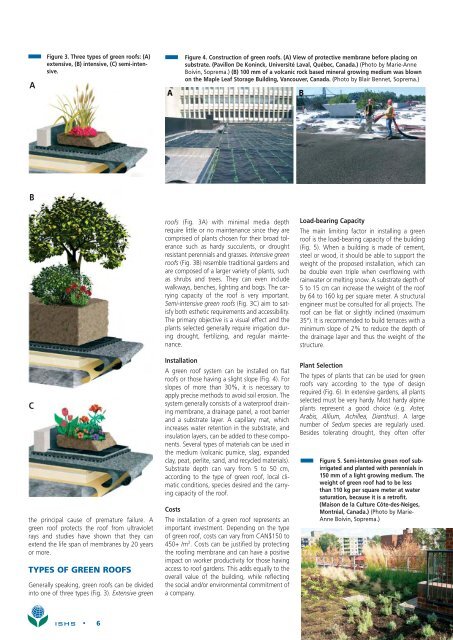Chronica Horticulturae volume 49 number 2 ... - Acta Horticulturae
Chronica Horticulturae volume 49 number 2 ... - Acta Horticulturae
Chronica Horticulturae volume 49 number 2 ... - Acta Horticulturae
Create successful ePaper yourself
Turn your PDF publications into a flip-book with our unique Google optimized e-Paper software.
A<br />
Figure 3. Three types of green roofs: (A)<br />
extensive, (B) intensive, (C) semi-intensive.<br />
Figure 4. Construction of green roofs. (A) View of protective membrane before placing on<br />
substrate. (Pavillon De Koninck, Université Laval, Québec, Canada.) (Photo by Marie-Anne<br />
Boivin, Soprema.) (B) 100 mm of a volcanic rock based mineral growing medium was blown<br />
on the Maple Leaf Storage Building, Vancouver, Canada. (Photo by Blair Bennet, Soprema.)<br />
B<br />
C<br />
the principal cause of premature failure. A<br />
green roof protects the roof from ultraviolet<br />
rays and studies have shown that they can<br />
extend the life span of membranes by 20 years<br />
or more.<br />
TYPES OF GREEN ROOFS<br />
Generally speaking, green roofs can be divided<br />
into one of three types (Fig. 3). Extensive green<br />
roofs (Fig. 3A) with minimal media depth<br />
require little or no maintenance since they are<br />
comprised of plants chosen for their broad tolerance<br />
such as hardy succulents, or drought<br />
resistant perennials and grasses. Intensive green<br />
roofs (Fig. 3B) resemble traditional gardens and<br />
are composed of a larger variety of plants, such<br />
as shrubs and trees. They can even include<br />
walkways, benches, lighting and bogs. The carrying<br />
capacity of the roof is very important.<br />
Semi-intensive green roofs (Fig. 3C) aim to satisfy<br />
both esthetic requirements and accessibility.<br />
The primary objective is a visual effect and the<br />
plants selected generally require irrigation during<br />
drought, fertilizing, and regular maintenance.<br />
Installation<br />
A green roof system can be installed on flat<br />
roofs or those having a slight slope (Fig. 4). For<br />
slopes of more than 30%, it is necessary to<br />
apply precise methods to avoid soil erosion. The<br />
system generally consists of a waterproof draining<br />
membrane, a drainage panel, a root barrier<br />
and a substrate layer. A capillary mat, which<br />
increases water retention in the substrate, and<br />
insulation layers, can be added to these components.<br />
Several types of materials can be used in<br />
the medium (volcanic pumice, slag, expanded<br />
clay, peat, perlite, sand, and recycled materials).<br />
Substrate depth can vary from 5 to 50 cm,<br />
according to the type of green roof, local climatic<br />
conditions, species desired and the carrying<br />
capacity of the roof.<br />
Costs<br />
The installation of a green roof represents an<br />
important investment. Depending on the type<br />
of green roof, costs can vary from CAN$150 to<br />
450+ /m 2 . Costs can be justified by protecting<br />
the roofing membrane and can have a positive<br />
impact on worker productivity for those having<br />
access to roof gardens. This adds equally to the<br />
overall value of the building, while reflecting<br />
the social and/or environmental commitment of<br />
a company.<br />
Load-bearing Capacity<br />
The main limiting factor in installing a green<br />
roof is the load-bearing capacity of the building<br />
(Fig. 5). When a building is made of cement,<br />
steel or wood, it should be able to support the<br />
weight of the proposed installation, which can<br />
be double even triple when overflowing with<br />
rainwater or melting snow. A substrate depth of<br />
5 to 15 cm can increase the weight of the roof<br />
by 64 to 160 kg per square meter. A structural<br />
engineer must be consulted for all projects. The<br />
roof can be flat or slightly inclined (maximum<br />
35°). It is recommended to build terraces with a<br />
minimum slope of 2% to reduce the depth of<br />
the drainage layer and thus the weight of the<br />
structure.<br />
Plant Selection<br />
The types of plants that can be used for green<br />
roofs vary according to the type of design<br />
required (Fig. 6). In extensive gardens, all plants<br />
selected must be very hardy. Most hardy alpine<br />
plants represent a good choice (e.g. Aster,<br />
Arabis, Allium, Achillea, Dianthus). A large<br />
<strong>number</strong> of Sedum species are regularly used.<br />
Besides tolerating drought, they often offer<br />
Figure 5. Semi-intensive green roof subirrigated<br />
and planted with perennials in<br />
150 mm of a light growing medium. The<br />
weight of green roof had to be less<br />
than 110 kg per square meter at water<br />
saturation, because it is a retrofit.<br />
(Maison de la Culture Côte-des-Neiges,<br />
Montréal, Canada.) (Photo by Marie-<br />
Anne Boivin, Soprema.)<br />
ISHS • 6
















